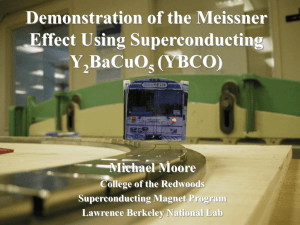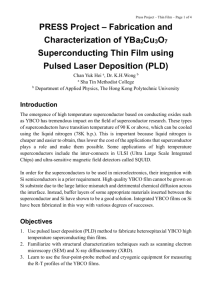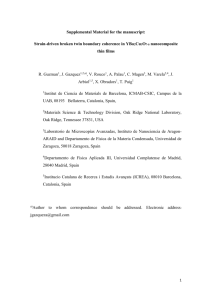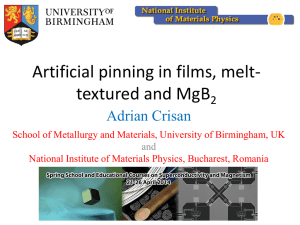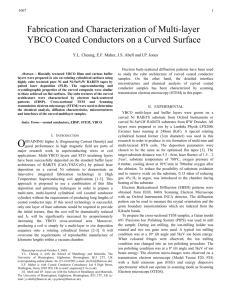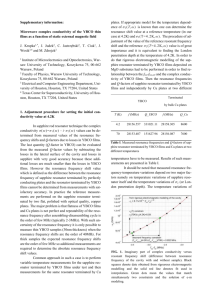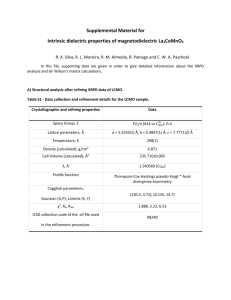LCMO - Materials Science Institute of Madrid
advertisement
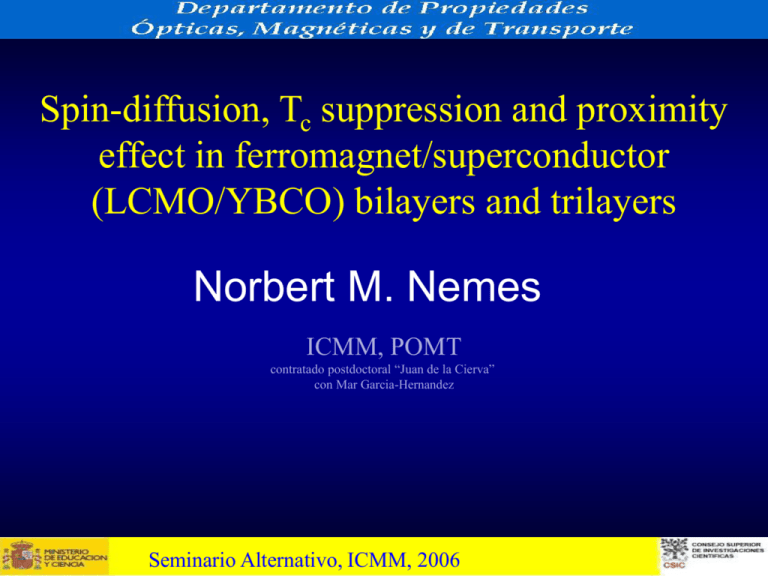
Spin-diffusion, Tc suppression and proximity effect in ferromagnet/superconductor (LCMO/YBCO) bilayers and trilayers Norbert M. Nemes ICMM, POMT contratado postdoctoral “Juan de la Cierva” con Mar Garcia-Hernandez Seminario Alternativo, ICMM, 2006 project ideas, sample-growth, characterization (x-ray reflectivity, TEM etc.), magnetization (SQUID): Vanessa Pena, Zouhair Sefrioui, D. Arias, Carlos Leon, and Jacobo Santamaria GFMC, Departamento Fisica Aplicada III, Universidad Complutense de Madrid magnetoresistace: Jose Luis Martinez, Mar Garcia-Hernandez Instituto de Ciencia de Materiales de Madrid polarized neutron reflectivity Susanne G. E. te Velthuis and Axel Hoffmann Materials Science Division, Argonne National Laboratory high-res. TEM, STEM, EELS Maria Varela Oak Ridge National Laboratory Seminario Alternativo, ICMM, 2006 What can happen when a ferromagnet and a superconductor get too close? Andreev reflection NO with LCMO! http://www.csr.umd.edu/csrpage Proximity effect via exchange fields of ferromagnet suppressing superconductivity =1 F Reflection (triplet correlations) =0 Inverse proximity effect Bergeret et al PRB69 (2004) (induced surface spin polarization in superconductor) Magnetic exchange coupling (as in GMR devices) spin imbalance in superconductor due to Takahashi et al PRL82 (1999) injection or diffusion of spin-polarized carriers stray dipole fields of ferromagnet creating vortices in superconductor M. Eschrig et al PRL 90, (2003); Volkov et al PRL 90, (2003); S Sa de Melo PRL79 (1997) . . . . . . Seminario Alternativo, ICMM, 2006 F F Spin transport between 2 ferromagnets through a superconductor S. Takahashi, I. Imamura and S. Maekawa, Phys. Rev. Lett 82, 3911 (1999) P Alignment AP Alignment Thus far the same is true with normal metal spin-switch devices Tc What is extra with a superconductor? Increased density of quasi-particles!!! Current in plane: Tc Exchange splitting vs bandwidth EF Eex=3 eV Eex=0.6 eV W=4.5 eV Ni Ferromagnet EF LCMO Half-metallic Ferromagnet W Ferromagnets 400 300 Saturation Magnetisation 3 M (emu/cm ) 200 100 0 -100 -200 Saturation Field -300 -400 -2000 0 2000 H (Oe) Coercive Field Seminario Alternativo, ICMM, 2006 Superconductors Perfect diamagnet, expunges field χ=-4π: 1200 4x10 -4 900 2x10 -4 m (emu/Nbil) Resistance ( ) Perfect conductor R=0: 600 300 0 0 100 200 300 T (K) 0 -2x10 -4 -4x10 -4 -4000 -2000 0 2000 4000 H (Oe) Type I: coherence length > penetration depth no vortices Type II: coherence length < penetration depth vortices YBCO is extreme type II as coherence length is very short Seminario Alternativo, ICMM, 2006 Hc1 [La0.7Ca0.3MnO3 / YBa2Cu3O7 ] Interface LCMO Ba YBCO Y Ba La 2 nm LCMO terminates in MnO !!! M. Varela and S.Pennycoock La0.7Ca0.3MnO3 /YBa2Cu3O7./ La0.7Ca0.3MnO3 F/S/F trilayers X-ray STEM Intensity (a.u.) LYL 40 c.u. LC M O 35 c.u. YBCO YBCO 17.5 c.u. YBCO 13.5 c.u. YBCO 10 c.u. YBCO LCMO 8 c.u. YBCO 2 4 6 2q 8 10 Z-contrast M. Varela and S.Pennycoock Experiment •Grow F/S/F trilayers •dF La0.7Ca0.3MnO3 0.5453 nm/u.c. dS YBa2Cu3O7 •Measure transport: current in plane (CIP) 1.1682 nm/u.c. •Sweep magnetic field: in plane Why manganite and HighTc-YBCO? LCMO: fully spin polarised, half-metal small exchange fields YBCO: short coherence length high Tc Short range pair-breaking, high quality, smooth interfaces, good lattice matching Seminario Alternativo, ICMM, 2006 Polarised neutron reflectivity: AP alignment in F/S/F trilayers V. Peña et al. Phys Rev. Lett. 94 57002 (2005) Peak in magnetoresistance occurs for AP alignment of F layers 450 0.18 0.16 150 0 0.14 -150 0.12 -300 -450 -300 0 H (O e) 300 0.10 R ( ) 3 M (emu/cm ) 300 Neutron reflectometry: IPNS @ Argonne Ntl. Lab. 0 10 Bottom LCMO 300 3 M [emu/cm ] 600 Top LCMO 0 -300 -600 0 100 200 H [Oe] Reflectivity -2 T=58 K T=50 K 300 10 H = 80 Oe -4 1x10 There exists a region of AP alignment top and bottom saturation magnetizations are also different + I I H = 120 Oe -6 10 0.01 0.02 0.03 -1 q [Å ] 0.04 0.05 Pena et al. Figure 3 Seminario Alternativo, ICMM, 2006 V. Peña et al. Phys Rev. Lett. 94 57002 (2005) LYL: STO / 40LCMO / NYBCO / 40LCMO 400 4 YBCO 300 3 100 0 -100 -200 -100 -400 -400 -200 0 200 400 -400 -200 H (Oe) 11 YBCO 300 3 100 0 -100 -200 20 YBCO -200 -400 -200 0 200 400 -400 200 3 M (emu/cm ) 3 300 100 0 -100 -200 0 200 400 H (Oe) 15 20 25 30 35 40 45 d (YBCO unit cell) top LCMO bottom LCMO 5 10 15 20 25 30 35 40 45 d (YBCO unit cell) 40 YBCO -400 400 10 0 -300 200 5 -100 -200 0 0 0 100 -300 -200 150 200 -200 -400 200 50 150 H (Oe) 30 YBCO -400 200 0 0 H (Oe) 400 250 100 50 -100 -400 250 Hcoup-Hcodown 300 100 0 -300 -400 M (emu/cm ) 400 100 -300 300 200 200 M (emu/cm ) 3 M (emu/cm ) 200 400 0 H (Oe) 400 350 300 -200 -400 400 350 0 -300 300 400 100 -300 400 Coercive fields of the top and bottom LCMO in trilayers 200 M (emu/cm ) 3 M (emu/cm ) 200 8 YBCO Hcoerc () 300 Hcoerc () 400 T > Tc -400 -200 0 H (Oe) 200 400 With increasing YBCO thickness coercive fields change and region of AP alignment diminishes Seminario Alternativo, ICMM, 2006 LCMO YBCO LCMO STO 310 10 R () 0.18 Rmax 0.16 0.14 0.12 0.10 Rmin -5000 MR 0 H (Oe) 5000 Rmax Rmin Rmin D D 10 2 Temperature D 10 10-1 D -2 D 110 D 10 10-3### D ### D 0 -4### D 10 10 ### -7500 0 7500 D -1 ### H (Oe) D 10 ### ### D 51### 54 57 60 D ### D ### T (K) increases D Magnetoresistance ### D ### 0 R () MR (%) 0.20 1 with### lower temperature ### V. Peña et al. Phys Rev. Lett. 94 57002 (2005) Seminario Alternativo, ICMM, 2006 3 10 20 How can we compare GMR 10 of various samples? 0 55 60 65 70 T(K) YBCO 15uc 2 10 MR (%) (Rmax-Rmin)/Rmin % The little issues 30 experimentalists have: YBCO 24uc 1 10 0 10 100 500 -1 100 10 0 5 10 15 5 10 15 20 25 T(K) 20 25 T(K) 30 30 35 YBCO 13.5uc 1 0.1 54 57 0.01 1E-3 60 1E-4 1E-5 T (K) 200 48 50 52 T(K) 100 40 0 35 R() YBCO 6 uc 1 50 0 0 (Rmax-Rmin)/Rmin % 150 R () (Rmax-Rmin)/Rmin % 100 10 10 400 51 300 200 48 40 Seminario Alternativo, ICMM, 2006 50 52 T(K) 54 54 50A 100A 500A 1000A 5000A 56 LCMO LCMO YBCO LCMO YBCO YBCO LCMO STO STO YBCO: 8 u.c. 10 10 1 1 0.1 0.01 1E-3 0.1 LCMO moments 0.01 aligned: 1E-3 Rmax: antiparalel STO YBCO: 10 10 u.c. YBCO: 40 u.c. 1 R () 100 R () R () 100 LCMO 0.1 LCMO moments LCMO moments 0.01 aligned: aligned: Rmax: antiparalel R : antiparalel 1E-4 Rmin: paralel 1E-4 1E-3 1E-5 1E-5 1E-4 max Rmin: paralel Rmin: paralel 30 32 34 36 38 40 42 42 44 44 46 48 66 50 52 68 54 70 T (K) Pair-breaking effect is largerTwith (K) thin YBCO! T (K) Seminario Alternativo, ICMM, 2006 72 1.2 10 R () 1 0.1 0.01 1E-3 1E-4 1E-5 YBCO: 81.0 u.c. Tc = T[Rmax] - T[Rmin] 100 ΔTc YBCO 40uc 30uc 24uc 17.5uc 15uc 8uc 6uc 0.8 0.6 LCMO moments 0.4 aligned: Rmax: antiparalel 0.2 Rmin: paralel 30 32 340.036 38 40 42 44 1E-6 1E-5 1E-4 1E-3 T (K) R/R normal Seminario Alternativo, ICMM, 2006 0.01 0.1 1 Tc(R/Rn=0.0001) 1 0.1 0.01 ~24nm ~9nm 0 5 10 15 20 25 30 35 40 dYBCO (unit cells) Spin diffusion length in YBCO: ~9nm >> ξGL Seminario Alternativo, ICMM, 2006 Quasi-particles with E>Δ may diffuse, reflect in AP alignment and pile up in superconductor they suppress Δ and Tc self-consistently LYL: STO / 40LCMO / NYBCO / 40LCMO 4 YBCO 300 8 YBCO 3 100 0 -100 -200 -300 100 -100 0 200 400 -400 -200 400 300 3 M (emu/cm ) 3 M (emu/cm ) 0 -100 -200 -300 20 YBCO 100 -100 -200 0 200 400 -400 3 3 300 M (emu/cm ) 0 -100 -200 -200 0 200 400 150 H (Oe) 50 200 0 0 5 10 15 20 25 30 35 40 45 d (YBCO unit cell) 150 0 0 top LCMO bottom LCMO 5 10 15 20 25 30 35 40 45 d (YBCO unit cell) 100 0 -100 -400 0 100 40 YBCO -300 -400 -200 250 200 -200 -300 -400 200 H (Oe) 400 30 YBCO 100 250 50 -200 H (Oe) 200 Hc2-Hc1 300 100 0 -400 -400 M (emu/cm ) 400 -300 -400 300 200 200 100 400 0 H (Oe) 11 YBCO 200 350 Antiferromagnetic exchange coupling of LCMO layers is mediated by spin polarized carrier? -200 H (Oe) 300 400 300 -200 -400 -400 Coercive fields of the top and bottom LCMO in trilayers 350 0 -300 -400 400 400 200 M (emu/cm ) 3 M (emu/cm ) 200 T > Tc Hcoerc () 300 400 Hcoerc () 400 200 400 -400 -200 0 H (Oe) 200 400 24nm: - electron mean free path in YBCO - Change of linear behavior of ΔTc - Length-scale of decay for thicker films With increasing YBCO thickness coercive fields change and region of AP alignment diminishes Seminario Alternativo, ICMM, 2006 24uc YBCO 8uc YBCO 0.6 Tc = T[Rmax] - T[Rmin] R () 1 0.1 0.01 1E-3 -60000 -40000 -20000 0 20000 40000 60000 0.4 0.2 0.0 1E-4 H (Oe) 15uc YBCO I perp. H I paralel H 1E-3 0.01 0.1 1 10 100 R(Ohm) 1.0 10 YBCO 13.5uc 1 400 R() Tc = T[Rmax] - T[Rmin] (Rmax-Rmin)/Rmin % 0.8 Peaks can not originate from vortices 8uc YBCO 100 500 0.1 0.01 1E-3 0.6300 1E-4 1E-5 0.4200 100 0.2 0 48 50 0.0 1E-5 1E-4 1E-3 0.01 Seminario Alternativo, ICMM, 2006 0.1 R(Ohm) 48 based on H-sweep 500uA, based on T-sweeps 5000uA 4000uA transition 3000uA 50 52 54 50A T(K) 2000uA 1000uA 100A 100uA 500A 10uA 1000A 1uA 5000A 0.1uA 52 1 10 T(K) 54 100 56 Effect small in bilayers So, dipole-field effect is ruled out Bilayers H (Oe) BYL04D 40-10-40 -1000 0.015 -800 -600 -400 -200 0 400 600 800 -1000 1000 202.8 -800 0.10 202.6 -600 -400 -200 0 200 400 600 800 1000 90.75K 86K 0.09 0.014 90.10 202.4 0.012 96K 202.0 56K 0.011 -1000 -800 -600 -400 -200 201.8 0 200 400 600 800 1000 H (Oe) MR@Rmin=104Ω 100%, broad R () 202.2 0.08 R () 0.013 R () 0.07 0.06 What is wrong with this sample? 90.05 0.05 -1000 -800 -600 -400 -200 0 200 400 600 800 1000 H (Oe) -1500 3.7 -1000 -500 0 500 1000 1500 268.9 268.8 268.7 3.6 268.6 R() MR@Rmin=10-4Ω 25%, very narrow R () R () 9/26/2005 15:59:57 BLY03D STO-10YBCO-40LCMO 9/26/2005 15:36:55 200 268.5 268.4 PYL01D 6P-5Y-35L 3.5 -1500 10/3/2005 23:36:13 268.3 -1000 -500 0 H (Oe) 500 1000 1500 MR@Rmin=10-4Ω Very small In a particular bilayer: evidence of proximity effect resistivity drops when magnetisation of ferromagnet is non-uniform STO-6PBCO-4YBCO-40LCMO 65 K upsweep downsweep 0.0002 100 K M(H) 100 K dM/dH -0.0002 0.045 -10000 0.0000 M(emu) R () 0.050 -5000 0 H (Oe) 5000 10000 Conclusions Large magnetoresistance in FM/SC/FM trilayers due to polarised spin diffusion when FM are aligned AntiParalel Tc is suppressed by AP alignment, this pair-breaking increases for thinner YBCO Spin diffusion length can be estimated as 9 nm >> coherence length Seminario Alternativo, ICMM, 2006 [La0.7Ca0.3MnO3 (15 u.c.)/ YBa2Cu3O7 (n u.c.)] superlattices resistance a.c. susceptibility R( 10 5 10 3 10 n=3 0,0 -6 a.c. ) n=1 n=2 n=5 -2,0x10 n=4 -6 -4,0x10 1 n=5 -6 n=8 -6,0x10 10 -1 10 -3 0 0 50 100 T (K) 150 200 25 50 T(K) 75 100 [La0.7Ca0.3MnO3 (15 u.c.)/ YBa2Cu3O7 (n u.c.)] superlattices F/S interaction !!! 1/ 2 hDS S k BTc 100 PBCO spacer 80 Tc 60 LCMO spacer 40 20 0 dScr 0 2 4 6 8 10 12 N (unit cells) Z. Sefrioui et al APL 81, 4568 (2002) dScr ~ 0.6nm 2.4 nm = 4 S dScr = 25 nm V/FeV dScr = 70 nm Fe/Pb/Fe [La0.7Ca0.3MnO3 (m u.c.)/ YBa2Cu3O7 (5 u.c.)] superlattices Fixed YBa2Cu3O7 (5 u.c.) thickness Varying La0.7Ca0.3MnO3 (3<m<90 u.c.) thickness 3 m=60 500 100 3 1 m=3 10 MS (emu/cm ) 10 R ( ) m=30 -1 400 50 M 10 300 0 -50 -100 200 -4000 0 H (Oe) 4000 100 10 0 -3 0 50 100 150 200 250 300 T(K) 1 10 NM (unit cells) 100 [La0.7Ca0.3MnO3 (m u.c.)/ YBa2Cu3O7 (5 u.c.)] superlattices 4DF F Eex 100 Tc ( K ) 80 1/ 2 0.2nm 60 40 dFcr 20 0 1 10 N M ( unit cells ) ~ 20 nm !!! 100 Very long length scale into the ferromagnet!!! Z. Sefrioui et al cond-mat/0301235 (2003) Seminario Alternativo, ICMM, 2006
